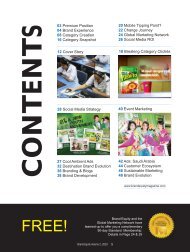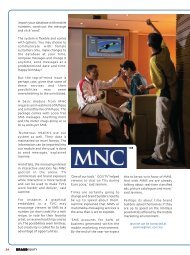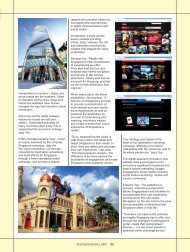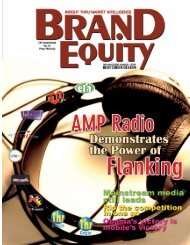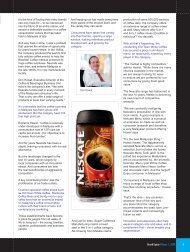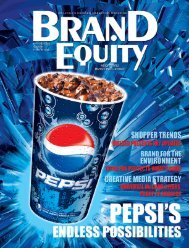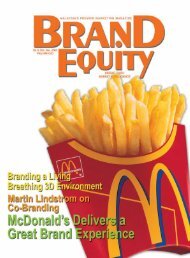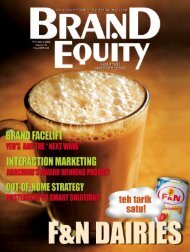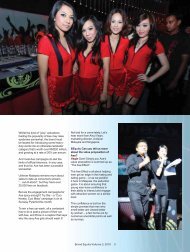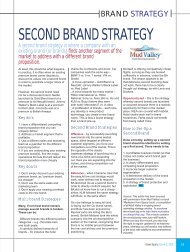COVER final - Brand Equity Magazine
COVER final - Brand Equity Magazine
COVER final - Brand Equity Magazine
You also want an ePaper? Increase the reach of your titles
YUMPU automatically turns print PDFs into web optimized ePapers that Google loves.
22 BRANDEQUITY
<strong>Brand</strong> <strong>Equity</strong> MEDIA STRATEGY<br />
Andy Miller<br />
24 BRANDEQUITY<br />
By R. Venkateswaran<br />
Fact: Only 20% of individual<br />
behaviour operates at the conscious<br />
level. The challenge is to tap into<br />
the remaining 80%, the subconscious<br />
recess that carries behavior driving<br />
motives.<br />
And in the media environment,<br />
simplistic analysis, planning, buying<br />
and execution has given way to<br />
compelling creative approaches that<br />
seek to move brands right into the<br />
consumer’s mind & heart.<br />
Consigning convention to<br />
oblivion is at the heart of Vizeum’s<br />
client engagement strategy. The<br />
independent media specialist, a unit<br />
of communications conglomerate<br />
Aegis pioneered the art of<br />
matching consumer behavior and<br />
media through a common thread<br />
– human motives; and is the<br />
only media agency that applies<br />
motivational factors strategically in<br />
communications planning.<br />
‘The core of our strategy hinges<br />
on the Motivation to Media concept,<br />
which involves understanding<br />
people’s motivations and matching
them with the right brands to the<br />
right moment, and delivered in the<br />
right media for greater impact,’ says<br />
Andy Miller, Vizeum’s CEO.<br />
Vizeum used an ‘inside out’<br />
approach to get into the consumer’s<br />
mind, understand their lives and<br />
identify the moments when they will<br />
connect with a particular brand.<br />
Case in point: A TVC featuring<br />
a happy family scene broadcast<br />
immediately after a family-oriented<br />
sitcom has a higher probability of<br />
making a stronger impression on the<br />
viewer because of the congruency of<br />
the projected emotions of the sitcom<br />
and the commercial.<br />
‘The combination of our scientific<br />
approach on consumer insights<br />
backed with extensive media<br />
planning expertise and support<br />
gives clients a genuine competitive<br />
advantage,’ says Miller. Vizeum’s<br />
clients in Malaysia include Tourism<br />
Malaysia, Nippon Paint, Perodua,<br />
High Five Bread and among others,<br />
MNC Wireless.<br />
Vizeum’s eight core motivations<br />
– enjoyment, conviviality, belonging,<br />
security, control, recognition, power<br />
and vitality form the basis of the<br />
subconscious mind. Against this, a<br />
new framework, the ‘Motivations<br />
Map’ further classifies the types<br />
of moods and brands a consumer<br />
is more receptive to in a given<br />
moment.<br />
Sometimes individuals are<br />
motivated by the desire to enjoy<br />
themselves on a Saturday night. Or<br />
the consumer may demonstrate<br />
his power to suggest that he is in<br />
control. At other times, he may<br />
want to merge into a group and<br />
enjoy that sense of belonging.<br />
Vitality is the desire to experience<br />
new things, feel a sense of adventure<br />
and test the boundaries as may be<br />
experienced with extreme sports. At<br />
other times, there is the need to feel<br />
secure, during which the introduction<br />
of a security system may be timely.<br />
Point is – the various motives<br />
operate at different times in a<br />
consumer.<br />
The strategy is to capture that<br />
moment when the motive is in high<br />
gear and direct a message to the<br />
The Motivations Map<br />
Plotting People’s<br />
Behavior<br />
Soft Drinks on<br />
the Map<br />
BRANDEQUITY 25
consumer during that moment in<br />
order to elicit the right response.<br />
26 BRANDEQUITY<br />
<strong>Brand</strong><br />
Communication<br />
The above motivational framework<br />
throws some challenges when it is<br />
applied to certain media types but<br />
it can be more powerful if the brand<br />
motivation can be matched to the<br />
media motivation.<br />
A clear understanding of what<br />
persuades the customer to buy a<br />
specific brand can help to develop<br />
an appropriate communications<br />
strategy.<br />
Miller cited the experience of<br />
Coca-Cola in the UK as a prime<br />
illustration of the communications<br />
strategy used. Most people surveyed<br />
on why they drink Coca-Cola gave<br />
the conscious reasons such as taste<br />
and refreshment.<br />
However, the subconscious<br />
and core motivations were really<br />
Belonging and Conviviality – most<br />
people bought Coca-Cola because it<br />
satisfied their desire for brotherhood<br />
and connecting emotionally with<br />
others who drink Coca-Cola.<br />
The communications strategy was<br />
reflected in a poster campaign that<br />
gave a sense of optimism and warmth<br />
with executions such as ‘Group Hug’<br />
and ‘Everyone Has a Someone’. To<br />
top that, TV and cinema campaigns<br />
highlighted ‘Togetherness’<br />
– something that best highlights the<br />
need for belonging and conviviality<br />
motives.<br />
By identifying how media channels<br />
deliver against human motivation,<br />
media plans can be fine-tuned to<br />
forge a stronger connection.<br />
This has helped replace the old<br />
thinking – ‘How can the brand break<br />
through?’ with the new thought<br />
– ‘How can the brand be invited into<br />
people’s lives?’<br />
The result? A stronger connection<br />
between brands and consumers.<br />
For further details, please contact<br />
andy.miller@vizeum.com<br />
Various <strong>Brand</strong>s on<br />
the Map<br />
Unilever’s Deodorants<br />
on the Map<br />
TV Programs on<br />
the Map
www.nixfon.com<br />
Spice-Up your biz<br />
Add some flavour to your business.<br />
We'll help add sizzle to your website.<br />
At Nixfon, we are specialists in online business strategies and solutions, from web<br />
& multimedia design, web applications to web hosting services.<br />
We pledge to LISTEN to you… ENHANCE your ideas… and BLOW your mind with our<br />
designs and applications.<br />
Give us a call at 03-7806 5655 or e-mail marketing@nixfon.com for a personal consultation.
<strong>Brand</strong> <strong>Equity</strong> MOBILE MARKETING<br />
By R. Venkateswaran<br />
Pervasive, engaging and indispensable<br />
are some attributes that just about<br />
describe the power of SMS. However,<br />
its power is best demonstrated when<br />
it is used by companies to engage<br />
customers.<br />
Enter MNC Wireless, Malaysia’s<br />
leading mobile value-added-services<br />
specialist. The listed company helps<br />
clients to leverage opportunities in<br />
the mobile marketing environment<br />
through an array of proprietary<br />
solutions.<br />
At the helm as its CEO & Executive<br />
Director is industry pioneer and<br />
veteran Jasmine Lee. <strong>Brand</strong> <strong>Equity</strong><br />
caught up with Lee to discuss the<br />
customer engagement opportunities<br />
presented by a specific tool called<br />
Go!SMS.<br />
What it is<br />
Go!SMS is a web based DIY mass<br />
messaging tool that enables marketers<br />
to reach out and communicate with<br />
customers via SMS in a speedy,<br />
targeted and cost efficient way. The<br />
fact that it is easy to use is a principal<br />
advantage. And it encapsulates 3<br />
modules – Broadcast, Information on<br />
Demand (IOD) and Mailbox.<br />
The versatile Broadcast module<br />
facilitates the distribution of user<br />
28 BRANDEQUITY<br />
conceived, personalized messages to an<br />
entire database of customers. Companies<br />
may use it to promote new products, for<br />
lead generation and for announcements.<br />
Or customers can check their loyalty<br />
points, manage redemptions and renew<br />
their membership. Financial institutions<br />
may remind clients of payment due<br />
dates, facilitate balance inquiries or<br />
account usage alerts.<br />
The Mailbox module enables any<br />
organization to receive and manage real<br />
time information via SMS. The system<br />
enables automatic forwarding of received<br />
information to designated mobile<br />
numbers or email addresses. Users can<br />
customize the type of information that<br />
they want to receive as well.<br />
The Information on Demand<br />
(IOD) module provides 24 X 7 real<br />
time response to queries. The tool’s<br />
subscription based services and<br />
versatility provided by this solution<br />
qualifies it to be a mini-CRM. Insurance<br />
companies may use this module to<br />
provide real time response to proposal<br />
status and policy premium date to their<br />
agents.<br />
Go!SMS offers enormous flexibility<br />
for managing customer loyalty. However,<br />
the challenge is for users to constantly<br />
identify creative ways to harness its<br />
resourcefulness.<br />
Jasmine Lee can be contacted at<br />
jasmine@mnc.com.my<br />
Jasmine Lee
BRANDEQUITY 29
30 BRANDEQUITY
BRANDEQUITY 31
<strong>Brand</strong> <strong>Equity</strong> WEB MARKETING<br />
32 BRANDEQUITY<br />
Last time I introduced<br />
numbers 1 to 10 of<br />
the Top 20 ways to use<br />
RSS for your brand.<br />
Hopefully they left<br />
you wanting more!<br />
In this article I’ll<br />
complete the list, with<br />
a discussion of numbers<br />
11 - 20.<br />
Announcing job<br />
vacancies<br />
Most corporate websites have<br />
some variation on an “employment<br />
opportunities” section. But how often<br />
does the right job appear when a<br />
site visitor is looking for it? An RSS<br />
feed dedicated to job vacancies<br />
allows prospective employees to hear<br />
about opportunities as they become<br />
available-and receiving applications<br />
online can help reduce recruitment<br />
costs.<br />
Distributing<br />
information on<br />
product updates<br />
A lot of companies market products<br />
that require periodic updates, or for<br />
which new add-ons become available.<br />
A good example is software patches.<br />
With RSS we can let our customers<br />
know immediately about new updates<br />
and how to get them.<br />
Talking to an<br />
online community<br />
For many brands, marketers build<br />
online communities where owners and
enthusiasts can meet and interact,<br />
both with each other and with the<br />
brand. RSS can offer community<br />
members the opportunity to stay<br />
in touch with what’s going on. For<br />
example, members of a digital<br />
photography community can hear<br />
about workshops and competitions.<br />
This increases the time spent<br />
interacting with the brand and helps<br />
build loyalty, leading to repeat<br />
purchases.<br />
Delivering<br />
exclusive content<br />
to key customers<br />
Encouraging our best customers to be<br />
“brand ambassadors” is an accepted<br />
marketing practice, and RSS can help.<br />
We can use exclusive feeds to deliver<br />
content to selected key customers<br />
as a way to reward them for their<br />
loyalty. Some car brands, for example,<br />
hold regular parties for owners.<br />
RSS provides an ideal channel for<br />
distributing invitations, and is a great<br />
way to keep the brand in constant<br />
contact with its most loyal customers.<br />
Updating a<br />
calendar of events<br />
Sometimes customers need to be told<br />
about schedule changes. Let’s take an<br />
example here. Say you attend regular<br />
Pilates classes at your gym. If the<br />
time of one of the classes changes,<br />
you can keep up to date quickly<br />
and conveniently by RSS. And if the<br />
RSS feed goes to your palmtop, you<br />
can even find out about the change<br />
on your way to the class. Good for<br />
members, and good for the brand.<br />
Delivering timesensitive<br />
content to<br />
subscribers<br />
Many marketers promote brands<br />
that are in some way time-sensitive.<br />
Take baby products, for instance.<br />
Different products are suitable for<br />
different developmental stages. A<br />
website with information on baby<br />
care could offer RSS feeds providing<br />
information and advice at key stages,<br />
along with details of products such as<br />
infant formula that can be bought at<br />
those stages. This will add value to<br />
customers and allow for some good<br />
targeted marketing.<br />
Staying in<br />
regular contact<br />
with prospectsautomatically<br />
We can use RSS to help guide<br />
prospects down the path to a sale,<br />
without having to write and send<br />
individual emails. By sending RSS<br />
auto-responders according to a<br />
predetermined schedule, we can easily<br />
stay in constant touch with prospects<br />
that might otherwise be neglected.<br />
Delivering<br />
regular new content<br />
Not all regular communications are<br />
e-newsletters or special offers.<br />
Sometimes our customers want regular<br />
content simply because it’s useful to<br />
them. An example here would be a<br />
food manufacturer using RSS to deliver<br />
regular recipes based on its brands.<br />
A useful service to subscribers, and a<br />
great way to sell more products.<br />
Letting people know<br />
about forum updates<br />
I recently had a technical question<br />
about Microsoft Word. I couldn’t find<br />
the answer on Microsoft’s website,<br />
so I tried posting my question on<br />
a number of online forums. I then<br />
checked back every day to see if<br />
anyone posted a reply. Imagine how<br />
much time I could have saved if I’d<br />
been able to subscribe to an RSS feed<br />
that would notify me when the forum<br />
was updated.<br />
Subscriptions to<br />
Blogs and Podcasts<br />
This is probably the best known use for<br />
RSS, so I’ve deliberately left it until<br />
last. As with any regularly updated<br />
content, visitors like to be notified<br />
about updates to Blogs and Podcasts.<br />
And RSS has been the most widely<br />
accepted way of doing this for some<br />
time now.<br />
One of the great things<br />
about our industry is that<br />
we are constantly surprised<br />
by the lateral thinking and<br />
sheer creative verve of<br />
our colleagues. Predicting<br />
the future is an uncertain<br />
business at best. But one<br />
thing I’m sure of is that as<br />
RSS really takes off over the<br />
coming months and years,<br />
I’m going to be amazed by<br />
the new ways marketers find<br />
to use it to promote their<br />
brands.<br />
In this article I touched very<br />
briefly on Podcasts. In my<br />
next article in this series<br />
I’ll take a closer look at<br />
Podcasts, what they are,<br />
what they can do, and how<br />
we can use them to market<br />
our brands.<br />
BRANDEQUITY 33
<strong>Brand</strong> <strong>Equity</strong> BRAND AUDIT<br />
MARKET RESEARCH,<br />
BRAND AUDIT AND BRAND<br />
VALUATION - THE GENERAL<br />
DIFFERENCES<br />
A Systematic Approach to <strong>Brand</strong> Audit<br />
for Performance Measurement<br />
and Improvements Article Series.<br />
By Cseng Lim<br />
A brand innovator and alignment<br />
specialist, Lim works with and helps<br />
businesses that are serious about<br />
building and owning category leading<br />
brands. He can be contacted at<br />
info@easturban.com<br />
34 BRANDEQUITY<br />
<strong>Brand</strong> development, brand<br />
innovation, brand systemization<br />
and management have begun to<br />
take firm hold in most progressive<br />
organizations the world over. In<br />
a series of five articles I will<br />
share with readers the systematic<br />
approach we use to conduct brand<br />
audits for performance measurement<br />
and improvements.<br />
The articles will touch on a<br />
number of important aspects with<br />
regards to organizing, conducting<br />
brand audits, converting audit<br />
information into strategies and<br />
implementing results from a<br />
brand audit into action items<br />
that positively impact brand<br />
performance.<br />
The first in the series will<br />
provide a general understanding<br />
and highlight the considerations<br />
that companies should take into<br />
account when implementing an audit<br />
exercise for the brand.<br />
According to a report release by<br />
the CMO Council of USA, less than<br />
20% of companies in the United States<br />
have meaningful and up-to-date<br />
marketing performance measurement<br />
system within their organization.<br />
This percentage is indeed alarming<br />
considering that companies in the<br />
USA would probably be among the<br />
first in the world to adopt systematic<br />
procedures to track performance of<br />
their brands.<br />
At the same time, that percentage<br />
indirectly, though inconclusively and<br />
without proper research data, may<br />
indicate that the total number of<br />
companies in Asia that have any form<br />
of satisfactory marketing performance<br />
measurement system is likely to be<br />
low.<br />
The report by the CMO Council<br />
of USA also indicates that 80% of<br />
companies in the United States
are dissatisfied with their current<br />
ability to benchmark their marketing<br />
performance and assess its impact<br />
upon business as well as value to<br />
their organization. I would assume<br />
that the percentage would equally<br />
apply to companies in Asia too.<br />
This just goes to show although we<br />
are operating in an information<br />
and knowledge rich society where<br />
application of technologies are quite<br />
pervasive in organizational operations,<br />
certain operations such as the brand<br />
development and marketing still lack<br />
the proper tools and mechanisms<br />
that allowed managers to affirm the<br />
ROI poured into advertising & other<br />
promotions activities as well as other<br />
brand development activities.<br />
“Running blind” seems to be<br />
appropriate description of the state<br />
of marketing in the world today if the<br />
findings of the CMO Council of USA are<br />
accepted by decision makers.<br />
However, the most important<br />
conclusion that the CMO Council<br />
of USA has offered in its report<br />
is that companies that do have<br />
comprehensive systems and mechanics<br />
to measure and track their marketing<br />
performance do show superior<br />
financial returns than those which do<br />
not have.<br />
This evidence is important to the<br />
development of marketing and brand<br />
building practices as it underlies the<br />
importance of making such investment<br />
to create and own such systems.<br />
The first and most basic<br />
understanding that managers should<br />
have is the general differences<br />
between market research, a brand<br />
audit and brand valuation. Although<br />
the basis of the three activities is the<br />
same where data or information are<br />
obtained through research methods<br />
to source them from a group of target<br />
audience/subjects, the differences<br />
lies in the objectives and relative<br />
relationships of the subjects being<br />
researched.<br />
A market research is usually<br />
characterized as a macro picture<br />
oriented study of the general<br />
relationships on market forces and<br />
participants of the market being<br />
studied. It usually provides managers<br />
with insights that will allow them to<br />
form macro level business strategies<br />
for the company to engage the market<br />
effectively. Among the common<br />
parameters being studied in a market<br />
research work are trends, industry<br />
factors that promote or inhibit<br />
growth, growth levels, identification<br />
of market participants – competitors,<br />
new entrants etc, sources of new<br />
developments and others.<br />
Market research reports are<br />
important for managers to determine<br />
the general direction, or propose<br />
markets that they should be operating<br />
in to maximize returns, capture new<br />
markets or suggest exploring new<br />
opportunities that arises.<br />
Though a brand audit relies<br />
on certain information contained<br />
in market research reports such<br />
as identification of the industry<br />
participants and general information<br />
on factors promoting and inhibiting<br />
growth of the market, it is still<br />
distinctively different.<br />
less than 20% of<br />
companies in the<br />
United States have<br />
meaningful and upto-date<br />
marketing<br />
performance<br />
measurement<br />
system within their<br />
organization.<br />
A brand audit is a much more<br />
detailed study and focuses on the<br />
depth of understanding the different<br />
relationships between the interactive<br />
elements being studied.<br />
Market research generally has<br />
breath but lacks detailed depth<br />
on relationships of subjects cum<br />
elements being studied. <strong>Brand</strong>s<br />
study the brand relationships on<br />
a functional, emotional or selfexpressive/psychological<br />
level; as<br />
well as relationship influences and<br />
interactions on tangible and intangible<br />
elements that determine a brand’s<br />
failure or success.<br />
Many studies also deploy methods<br />
to link how functional level factors<br />
influence emotional and psychological<br />
states of perceptions, decision making<br />
and behavioral change upon users<br />
of the brand. Such levels of depth<br />
are usually not present in a market<br />
research study.<br />
The next level or rather a<br />
different parallel approach that<br />
some companies take to value their<br />
investment in branding and marketing<br />
is to track the dollar value of their<br />
brand over a period of time; or during<br />
critical times such as when going for<br />
IPO.<br />
Few established practices in<br />
this area such as <strong>Brand</strong> Finance via<br />
their <strong>Brand</strong> Asset Valuator model<br />
helps companies to benchmark and<br />
determine the value of their brand in<br />
the market. Interbrand also publishes<br />
the value of well known brands and<br />
ranks them in the order of their<br />
financial value annually. There are<br />
other methods that are used by brand<br />
consultancy firms around the world.<br />
At the moment, no one standard<br />
can be applied to every brand in<br />
every market in every country. The<br />
challenge to achieve such level of<br />
global acceptance will be Herculean<br />
and indeed ambitious for any one<br />
consultancy firm to undertake. At the<br />
moment the best advice I can give<br />
to companies is to seek out the most<br />
appropriate model that applies to<br />
their market, operating conditions and<br />
practices.<br />
This is important so that the<br />
valuation will do justice to their<br />
brand and investments that they have<br />
made. Although it will be nice to apply<br />
similar standards used by international<br />
brands, but doing so will greatly devalue<br />
the actual true worth of the<br />
local brands in their existing market as<br />
most of these local brands don’t yet<br />
operate on the international level.<br />
<strong>Brand</strong> valuation is a good practice<br />
to have in an organization in order<br />
that investment made can be justified.<br />
This is particularly important for<br />
companies that are going for M&A<br />
and also for IPO purposes where their<br />
brands should rightly form part of the<br />
valuation of the total asset owned by<br />
the company.<br />
There are a good number of<br />
companies in Malaysia that can help<br />
undertake proper market research for<br />
your business needs, but only a small<br />
number are capable of undertaking<br />
brand audit work; and even lesser the<br />
number of companies that can do a<br />
comprehensive brand valuation.<br />
In my next article I will explain<br />
a brand audit’s considerations,<br />
objectives, types and how to evaluate<br />
ROI as well.<br />
BRANDEQUITY 35
<strong>Brand</strong> <strong>Equity</strong> PUBLIC RELATIONS<br />
‘This Old<br />
Relationship<br />
Tangle...’<br />
36 BRANDEQUITY<br />
By Jane Prior<br />
Chief Executive Officer<br />
Resonance Communications<br />
Sdn Bhd A Priority<br />
Group Company<br />
jane.prior@priorityconsultants.com<br />
We recently started work on<br />
a quasi-government project<br />
and like all such assignments,<br />
experienced a rather steep<br />
learning curve as the mixed<br />
agendas all came into play -<br />
without doubt, an uphill task!<br />
As the project got<br />
underway, we learned a little<br />
more about the background<br />
of the job; the skills and<br />
strengths of the individuals<br />
in the client’s team but in<br />
no way could it be described<br />
as easy. One felt like a<br />
‘supplier’ and definitely not a<br />
‘partner’ and the concept of<br />
being either expert or valued<br />
seemed a remote piped<br />
dream...
In today’s<br />
business<br />
context we<br />
have de-valued<br />
the word and<br />
what it actually<br />
means to ‘have<br />
a relationship’<br />
with someone.<br />
Inevitably in such a situation, it is<br />
hard to not begin the ‘blame’ game<br />
and perceptions begin to creep in that<br />
one thing or another is the client’s<br />
fault... and allowing the reverse is<br />
true, they possibly felt we were the<br />
root cause of all evil.<br />
So where do we go in these<br />
situations - when client / partner<br />
relationships either begin to falter<br />
or they simply never get into step at<br />
all; when caller ID is more important<br />
than the call itself and the use of SMS<br />
appears a lot more attractive than<br />
actually having a conversation. Sounds<br />
familiar doesn’t it and we’ve all been<br />
there at one time or another and the<br />
answer to the problem lies in the<br />
relationship or in this case, the lack<br />
of relationship.<br />
In today’s business context<br />
we have de-valued the word and<br />
what it actually means to ‘have a<br />
relationship’ with someone. In fact,<br />
the very words used to conjure up an<br />
intimacy and familiarity that would<br />
almost inevitably raise eyebrows,<br />
whereas today a relationship seems<br />
to be little more than a coffee at<br />
a seminar or adjacent seats at an<br />
industry lunch!<br />
Relationships are tough - ask<br />
anyone with a teenager and they will<br />
tell you. Plus it’s easier to send an<br />
email than pick up the phone; to say<br />
‘let’s have lunch’ but never actually<br />
confirm - because that means getting<br />
into a car and being inconvenienced<br />
to have to actually leave our desk.<br />
How many times do we send bad<br />
news via sms - face it, it’s far easier<br />
to not have to answer in real-time any<br />
inconvenient truths... and in so doing<br />
miss out on the opportunity to say,<br />
‘how do you feel about this?’<br />
So - how do we really define a<br />
relationship? Think about that old<br />
school or college friend you meet<br />
again and how often ‘it was as if<br />
we just saw each other yesterday...<br />
nothing was any different’. All the<br />
familiar threads of ambition, likes,<br />
dislikes, lovers and movies, are so<br />
easily picked up and the tapestry<br />
continues to grow.<br />
We must establish this same<br />
benchmark in the business world if<br />
we are to be able to say we really do<br />
understand the power of relationships.<br />
Let’s face it - a true relationship can<br />
outride a storm or a downturn, can<br />
lead to bigger and better things and<br />
even grants the opportunity to explain<br />
your position in time of adversity; this<br />
latter point being the crux when it<br />
comes to relationships with staff, the<br />
media, partners and customers.<br />
So, looking at that personal<br />
relationship, there are two critical<br />
elements that also apply in the<br />
professional arena: learning and<br />
adaptation.<br />
In the learning relationship, each<br />
encounter builds on the one before it<br />
so that a dialogue can resume where<br />
it left off the last time. To give an<br />
example of this, how many of us know<br />
in detail what our customers are<br />
facing; the sales wins they are waiting<br />
to sign, the hiccups in the distribution<br />
network, HR concerns and that’s only<br />
the challenges.<br />
How about the successes - and<br />
human nature talks less about what<br />
feels good - but family, further<br />
studies, a new house or car, even<br />
birthdays are all very real things<br />
that bring excitement to our own<br />
day and why should the client be any<br />
less human? For any professional in<br />
the communications business, it is<br />
your business to know these things<br />
and a key personal attribute will be<br />
an ability to make sure that time is<br />
invested to create an opportunity<br />
to gather and to share this in-depth<br />
information.<br />
In most cases, it doesn’t fit on an<br />
agenda and in fact, it is the offagenda<br />
time that delivers this value -<br />
such as one of our long-term and great<br />
advocate clients who always asked,<br />
‘so, what’s the gossip?’ and then<br />
proceeded to have a two-way sharing<br />
of news and views. Unfortunately in<br />
today’s business world time is short<br />
and success in building a professional<br />
relationship will be measured by the<br />
intellect, industry knowledge and also<br />
willingness to be an ‘active listener’.<br />
Then we come to adaptation -and<br />
if it’s a relationship that you value,<br />
then you must adapt your behavior in<br />
the context of what you have learned<br />
and most importantly make sure that<br />
you never need to be told anything<br />
twice.... Yes! Your call is important<br />
to us, and by the way, what language<br />
shall we communicate in?<br />
Systems today are able to capture<br />
information beyond our wildest<br />
dreams and what’s more, we can<br />
access, manipulate and query that<br />
data to come up with a better<br />
understanding of our clients with a<br />
view to winning confidence and better<br />
customer share over the long term.<br />
These are the principals of oneto-one<br />
marketing and relationship<br />
management but the danger is that<br />
we see the big picture but lose out<br />
on the day-to-day needs to build<br />
a professional friendship with our<br />
customers.<br />
Back to our quasi-government<br />
organization; large and cumbersome it<br />
may be in some of its modus operandi,<br />
but the people who worked there<br />
were, at the end of the day, just that<br />
- they were people.<br />
So next time you hear a grumble<br />
in the corridor about the client from<br />
hell - perhaps they would respond well<br />
to some professional friendship that<br />
measures success in a collaborative<br />
basis and takes into account that<br />
everyone has high days and low days,<br />
and without doubt a birthday - at least<br />
once a year!<br />
In the learning<br />
relationship,<br />
each encounter<br />
builds on the<br />
one before it<br />
so that a<br />
dialogue<br />
can resume<br />
where it left<br />
off the last time.<br />
BRANDEQUITY 37
<strong>Brand</strong> <strong>Equity</strong> BRAND DIRECTION<br />
Roger Barnett<br />
Shaklee, a family brand that<br />
remains synonymous with high<br />
quality and efficacy is involved<br />
in a selected group of business<br />
areas namely nutrition, weight<br />
management, personal care, and<br />
healthy homes.<br />
Founded in 1956, Shaklee<br />
claims to be the number one<br />
natural nutrition company in the<br />
US, with over 700,000 members<br />
and distributors in the US, Japan,<br />
Mexico, Malaysia, and Canada.<br />
To appreciate the brand’s recent<br />
status and direction, <strong>Brand</strong> <strong>Equity</strong><br />
spoke to the company’s Chairman<br />
and CEO Roger Barnett.<br />
The essence<br />
of the Shaklee<br />
brand?<br />
Shaklee is about health, quality and<br />
opportunity. Unlike some brands,<br />
we stand for only one thing. Shaklee<br />
stands for integrity and is incredibly<br />
focused on maintaining the quality<br />
of its products. To us that means<br />
38 BRANDEQUITY<br />
staying focused on improving the<br />
quality of life in general by focusing<br />
on the physical and financial health<br />
of our customers, working towards a<br />
healthy planet and helping to raise<br />
the self esteem of those around us.<br />
The brand’s key<br />
proposition to<br />
customers?<br />
Well there are several things that<br />
help us stand head and shoulders<br />
above the competition. Firstly,<br />
Shaklee is about Quality. We’ve<br />
spent for example, more then<br />
USD 250 million in research and<br />
development of our products that<br />
are focused on the health and<br />
wellness industry. This includes<br />
researching and publishing over 100<br />
clinical studies and conducting over<br />
83,000 product quality tests a year!<br />
That’s one of the highest, if not<br />
the highest, in our industry. These<br />
efforts are directed toward creating<br />
the best natural health products<br />
available. When we say best we’re<br />
talking about making products that<br />
are the purest, safest and clinically<br />
proven to be effective.<br />
Target customers<br />
and key insights?<br />
Well to us, we’re looking at a<br />
rather unique segment as everyone<br />
is a potential customer. We have<br />
products for those who are older,<br />
children and everyone in between<br />
who care about living a healthier<br />
life; now that’s something that<br />
everyone wants, right?<br />
As far as insight goes we’ve been<br />
for the last 50 years developing<br />
the market. This was when people<br />
cared less about their health and<br />
were less aware of the value of<br />
nutritional supplements. Despite<br />
this, we were already educating<br />
people about the importance of<br />
this. Our insight is that of a pioneer<br />
then that has seen and been<br />
successfully educating millions of<br />
people around the world about the
importance of health and wellness<br />
from the perspective of prevention.<br />
How changing<br />
customers<br />
are impacting<br />
Shaklee’s<br />
positioning?<br />
There has been no impact to speak<br />
of. Our brand positioning is timeless<br />
and just as relevant today as it was<br />
fifty years ago<br />
Why are<br />
operations<br />
confined to 5<br />
markets?<br />
Well, the prior owners of the<br />
company were a large multinational<br />
pharmaceutical concern that did<br />
not fully maximise the growth<br />
potential of the company. In part<br />
the change in ownership and<br />
more entrepreneurial vision that<br />
came with that will help drive our<br />
expansion into different markets.<br />
Our products and our customer base<br />
are global and universal; and we<br />
are in a sufficiently diverse group<br />
of countries and markets to prove<br />
that both our product and business<br />
model is accepted in different<br />
cultures and geographies around<br />
the world. With that in mind, we<br />
are now going through the natural<br />
process of expansion which should<br />
lead to ever more dynamic growth<br />
opportunities for the future.<br />
Your principal<br />
brand delivery<br />
initiatives?<br />
Well public relations and outreach<br />
firstly. We also enjoy high profile<br />
partnerships that are mostly related<br />
to using our business model to<br />
tell the press about the issues of<br />
poverty and malnutrition around<br />
the world. Associated with these<br />
are sponsorships for those causes as<br />
well. We also leverage our existing<br />
network of over 750,000 members<br />
and distributors around the world<br />
to build the brand and spread our<br />
message.<br />
Shaklee’s<br />
performance in<br />
the Malaysian<br />
market?<br />
Over the past five years, Shaklee<br />
has seen significant growth in its<br />
local operations. While the sales<br />
turnover of the local direct selling<br />
industry was 118 percent, we<br />
recorded an astounding growth<br />
of 217 percent between 2000 and<br />
2005; that’s nearly double the<br />
industry average. That’s just an<br />
example of the growing awareness<br />
and acceptance of our brand here.<br />
Moving forward we expect to see<br />
our sales increasing 15% year on<br />
year for the next five years with<br />
the number of new distributors<br />
joining our family growing at 25%<br />
year on year during that time as<br />
well.<br />
Where do you<br />
see Shaklee in<br />
five years time?<br />
Over the next five years we hope to<br />
double the unaided awareness of<br />
the Shaklee brand in Malaysia and to<br />
have the brand stand for principles<br />
of superior quality in integrity and<br />
innovation. We’re also looking at a<br />
broader set of constituents beyond<br />
our current customer base.<br />
BRANDEQUITY 39
<strong>Brand</strong> <strong>Equity</strong> INTERACTION MARKETING<br />
40 BRANDEQUITY<br />
Chin Weng Keong
Selecting from a menu of<br />
scenarios, the website allows<br />
visitors to do exactly what they<br />
would love to but can’t in real life<br />
to such persons represented in the<br />
form of Mr. Soh Hem Sem – ‘punish’<br />
him for his smugness and sabotage<br />
his good looks.<br />
Yet despite all that gets thrown<br />
his way, Mr. Soh Hem Sem’s<br />
crowning glory regains its poise<br />
very quickly thanks to the easy<br />
reshaping power of Brylcreem Hair<br />
Wax range.<br />
Says Chin Weng Keong,<br />
Arachnid’s Managing Director, ‘This<br />
campaign is aimed at Malaysian<br />
men aged between 18 and 29<br />
years who may view Brylcreem<br />
as an ‘old world’ brand. What we<br />
sought to do is engage them via<br />
a contemporary touchpoint and<br />
vividly demonstrate the product<br />
benefits. It’s highly entertaining<br />
and involving, and will hopefully<br />
generate plenty of word-of-mouth<br />
traffic that would otherwise not<br />
have visited the site.’<br />
The involvement comes from<br />
some very interesting features on<br />
the website. Visitors are invited<br />
to suggest alternative ruses of<br />
messing up the hero’s hair. The<br />
best ideas will then be filmed and<br />
added to the site.<br />
Says Tang Wai Hoong, one of<br />
Arachnid’s Creative Heads, ‘It<br />
gives consumers the opportunity<br />
to be co-creators. A bit of<br />
brand ownership turned over to<br />
consumers, if you like. We’ve<br />
already started to get some<br />
incredible suggestions, which is<br />
fantastic. The wilder the better!’<br />
There’s more. ‘Another feature<br />
allows visitors to even replace Soh<br />
Hem Sem’s face with a picture of<br />
someone else they’d like to see<br />
messed up instead,’ says joint<br />
Creative Head Wong Hean Meng.<br />
‘Not only is that another avenue<br />
for consumers to interact with the<br />
brand but it is also a heck of a lot<br />
of fun and very viral!’<br />
Chin says, ‘We’re really excited<br />
about this new age marketing<br />
campaign – combining interactive,<br />
viral and user-generated content<br />
components with minimal<br />
traditional media support.’<br />
We sought<br />
to engage<br />
them via a<br />
contemporary<br />
touchpoint<br />
and vividly<br />
demonstrate<br />
the product<br />
benefits<br />
‘Our client Sara Lee Malaysia<br />
is just as excited and has<br />
wholeheartedly embraced<br />
engagement as a way forward for<br />
their brands. We are thrilled and<br />
grateful to be able to break new<br />
marketing communications ground<br />
with Sara Lee Malaysia.’<br />
About Arachnid Malaysia<br />
Arachnid is one of Malaysia’s most<br />
established interactive agencies<br />
since 1996, dedicated to providing<br />
marketers with new marketing<br />
solutions to interact with, involve<br />
and engage consumers. It is<br />
also Malaysia’s most-awarded<br />
interactive agency, with over 80<br />
major local and international<br />
awards for creative, strategy and<br />
results including The Kancil Awards,<br />
DMAM Awards, Malaysian Creative<br />
Circle Awards, The New York<br />
Festivals, Asia Interactive Awards,<br />
Asia-Pacific AdFest Awards and<br />
Global Finance <strong>Magazine</strong> Awards.<br />
Arachnid has been ranked twice<br />
(2002 and 2006) in the Deloitte Asia<br />
Pacific Fast 500 (the 500 fastestgrowing<br />
technology companies in<br />
Asia Pacific) and with its current<br />
team of 50 professionals, serves<br />
some of the biggest blue-chip<br />
multi-national brands in the world.<br />
Chin Weng Keong can be reached<br />
at wengky @arachnid.com.my<br />
(www.arachnid.com.my)<br />
BRANDEQUITY 41
<strong>Brand</strong> <strong>Equity</strong> BRAND COMMUNICATIONS<br />
The Brief<br />
* KFC is an established leader in the<br />
Quick Service Restaurant (QSR) business<br />
in Malaysia and around the world. As a<br />
continuous effort to satisfy its consumers,<br />
KFC expanded its variety to cater to more<br />
Malaysians by introducing new options,<br />
one of which is fish.<br />
* The KFC Alaskan Fish Burger was<br />
developed to meet the needs of Malaysian<br />
consumers who constantly seek for more<br />
variety and value. It is made of 100%<br />
Alaskan Pollack fish and coated with<br />
crispy Japanese crumbs, topped with<br />
cheese, lettuce, mayonnaise, tangy and<br />
spicy sauce, in a Kaiser bun. The KFC<br />
Alaskan Fish Burger is made with 30%<br />
more fish compared to any other fish<br />
burgers available in the market.<br />
* The task for BBDO was to ensure KFC’s<br />
very first fish item entered the market<br />
with impact.<br />
Strategy<br />
* BBDO’s proprietary trend-spotting<br />
tool ‘Incite Out’ provided learnings on<br />
consumer psyche that highlighted ‘value’<br />
as the main factor in consumer decisionmaking<br />
when it comes to choice of food.<br />
Based on that, BBDO developed a creative<br />
campaign entitled ‘30% More Fish’ to<br />
allow the ‘value’ proposition to ring out.<br />
* Cats, naturally associated with fish,<br />
were used as a mnemonic to further drive<br />
home the ‘tasty’ factor.<br />
The Big Idea<br />
* The concept was executed using<br />
traditional media (TV, print, radio), instore<br />
support, for mass outreach at every<br />
possible consumer touch-point.<br />
42 BRANDEQUITY
The Brief<br />
* One of KFCs best-selling items is the KFC<br />
Zinger burger, which was launched in 1997.<br />
Since its introduction, the crispy Hot & Spicy<br />
whole chicken fillet burger has been wellreceived<br />
by consumers and have established a<br />
following of its own.<br />
* As a constant effort to keep its menu fresh<br />
and appealing, KFC developed the KFC Zinger<br />
Maxx, a more premium version of the KFC<br />
Zinger burger. The new and improved KFC<br />
Zinger is a whole Hot & Spicy chicken fillet<br />
topped with lettuce, mayonnaise, cheddar<br />
cheese in a new premium Kaiser bun.<br />
* BBDO Malaysia was given the task to<br />
introduce the new KFC Zinger Maxx to<br />
Malaysians, as the ultimate burger of choice<br />
for youth and young adults.<br />
Strategy<br />
* Through BBDO’s proprietary trend-spotting<br />
tool ‘Incite Out’, the team developed a<br />
strategy to help KFC Zinger Maxx hit its target<br />
consumers. The ultimate burger of choice was<br />
positioned as something that was so good it<br />
was hard to let go of. And the tagline: ‘Tastes<br />
so good, you’ll never let go’.<br />
The Big Idea<br />
* The concept translated into a<br />
comprehensive communications plan,<br />
which integrated several mediums including<br />
traditional media (TV, print, radio), in-store<br />
and online support, for mass outreach at<br />
every possible consumer touch-point.<br />
* Ad visuals and the scenarios portrayed in the<br />
TVCs such as ‘Pianist’ and ‘Barber’ were kept<br />
relevant to the target consumers, to ensure<br />
they could relate to it.<br />
* The second phase of the campaign focused<br />
on an online microsite that encouraged<br />
consumer participation. People were<br />
encouraged to show off their one-handed<br />
skills by sending in pictures and video clips<br />
of themselves doing things with one hand to<br />
stand a chance to win gadgets worth more<br />
than RM40,000. Winners were picked on a<br />
weekly basis.<br />
Results<br />
* Within a month, the online microsite<br />
attracted over 9,000 views with over a<br />
hundred participations for the KFC Zinger<br />
Maxx one-handed skill competition!<br />
BRANDEQUITY 43 43
44 BRANDEQUITY<br />
BBDO Malaysia is part<br />
of BBDO Worldwide,<br />
one of the world’s<br />
largest advertising<br />
networks. BBDO<br />
Malaysia provides<br />
award-winning<br />
advertising and brand<br />
communications<br />
solutions to clients<br />
such as Hotlink, KFC,<br />
FedEx, Visa, Pepsi, KFC,<br />
ICI, SCA Hygiene, and<br />
M&Ms.<br />
The Agency’s most<br />
recent accolades include<br />
being named Agency<br />
of the Year 2005 by<br />
Advertising Age, Global<br />
Agency of the Year 2005<br />
by AdWeek, Advertising<br />
Network of the Year by<br />
Campaign Brief Asia<br />
and the Most Awarded<br />
Agency for Print and TV<br />
at Adfest this year.
<strong>Brand</strong> <strong>Equity</strong> 360 DEGREE CAMPAIGN<br />
GUINNESS PLANS FOR A GREAT<br />
EXPERIENCE WITH THE GUINNESS<br />
9-BALL TOUR CAMPAIGN<br />
Bonding, communion, sharing of great<br />
moments. Stuff marketers and branding<br />
prophets exhort and preach but find<br />
rather challenging to implement within<br />
a client’s brief and constrains.<br />
In a toast to genius (or should we<br />
say GUINNESS), GUINNESS has adopted<br />
a ready platform on which to build and<br />
extend these key attributes among the<br />
No.1 premium black beer connoisseurs.<br />
The Guinness 9-Ball Tour is GUINNESS<br />
maiden foray into sponsorship of pool<br />
as a cool game that is meant to be<br />
shared with friends on a relaxed night<br />
out. Just like GUINNESS is.<br />
Formerly the Asian 9-Ball Tour, the<br />
Guinness 9-Ball Tour has been made<br />
bigger and better with total prize<br />
money doubled to US$320,000 and will<br />
feature a Grand Final in Bali for the<br />
Top 10 players. The grand <strong>final</strong> will see<br />
the best pool players from around the<br />
Asia compete for the championship.<br />
All six stops of the Tour – Jakarta,<br />
Kaohsuing, Kuala Lumpur, Singapore,<br />
Shanghai and Bali will be telecast ‘live’<br />
on STAR Sports. The Malaysian leg will<br />
take place at Genting Highlands Resort<br />
from 15-17 June 2007.<br />
‘We are strongly committed towards<br />
building on the game of 9-Ball pool<br />
as the prefect opportunity to share<br />
great moments over a perfect pint of<br />
GUINNESS. As can be seen throughout<br />
the world, the cool pool phenomenon<br />
has swept across the United States,<br />
Europe and has now come to Asia. It<br />
seems almost unthinkable now for a<br />
club to open without including the<br />
pool table as an essential element of<br />
its entertainment mix for patrons,’<br />
said Sean Koh, Marketing Manager of<br />
GUINNESS.<br />
A 360 degree campaign has been<br />
internalized at Guinness Anchor<br />
Berhad (GAB) to communicate the<br />
commitment of GUINNESS towards pool<br />
and amplify its support of the Guinness<br />
9-Ball Tour. As you step into the GAB<br />
office at its Sungei Way Brewery in<br />
Petaling Jaya, visuals of the Guinness<br />
9-Ball tour adorn the lobby & lift<br />
entrance. Round table-tops carry the<br />
images of pool balls. Even the meeting<br />
room conference table has been turned<br />
into a giant pool table! On that note,<br />
an actual pool table has been placed<br />
inside the Tavern for the playing<br />
pleasure of all GAB staff, with the<br />
refreshing accompaniment of a cool<br />
pint of GUINNESS.<br />
A series of creative buys were<br />
placed in major dailies, the highlight<br />
of which was the front cover wrap<br />
of The Sun and a unique mock back<br />
cover of The Star. Of note would be<br />
the diagonal advertisement which was<br />
executed for the first time in major<br />
dailies. To further enhance its visibility<br />
and convey the massive breadth of the<br />
campaign, GUINNESS adopted strategic<br />
pillars of the monorail along Jalan<br />
Sultan Ismail and wrapped an entire<br />
monorail cabin with the Guinness 9-Ball<br />
Tour creative visuals.<br />
To embrace all the touch points,<br />
a specially-commissioned cue stick<br />
chopstick set will be given as premiums<br />
through the on-trade channel consumer<br />
promotion while a limited edition 3<br />
can packaged with a free exclusive<br />
GUINNESS tulip glass will also be<br />
offered at participating hypermarkets<br />
& supermarkets.<br />
‘As we wanted to bring the game<br />
closer to the general Malaysian public,<br />
we also launched the GUINNESS Black<br />
Challenge, a search for the fastest<br />
speed pool player in the country<br />
through approximately 115 clubs<br />
throughout the country. The Grand<br />
Champion will be whisked to romantic<br />
Bali to watch the Grand Finals of<br />
Guinness 9-Ball Tour. A ‘Get Spotted’<br />
car sticker contest was also rolled-out<br />
where weekly winners won an iPod<br />
Nano. To ensure that the experience<br />
was brought through the line, we<br />
placed a Virtual Speed Pool Quest on<br />
www.guinness.com.my. In a first for<br />
Malaysia, an Animated Interactive<br />
Screen on Pool was specially installed<br />
at selected major cineplexes, setting<br />
a milestone for customer interactivity<br />
with a brand,’ said Koh.<br />
GUINNESS will also be hosting the<br />
exclusive mega Black Party up in Arena<br />
of Stars, Genting Highlands Resort on<br />
16 th June for specially invited guests.<br />
Held in conjunction with the Guinness<br />
9-Ball Tour, this super-exclusive,<br />
invite-only party will feature some of<br />
the hottest acts in the country such<br />
as Camelia, DJ Gabriel and DJ Nesh.<br />
Expect a super-charged experience<br />
and memorable moments at the top.<br />
Entrance to the exclusive Black Party<br />
is through online invitation only. To<br />
get yourself these money-can’t–buy<br />
exclusive invites, log on to www.<br />
guinness.com.my. Make sure you get<br />
the limited invites early for this one!<br />
‘We wish you an enjoyable<br />
experience with the Guinness 9-Ball<br />
Tour and hope you savour the great<br />
moments with a nice cold pint of<br />
GUINNESS with friends!’ said Koh.
<strong>Brand</strong> <strong>Equity</strong> BRANDED CUSTOMER SERVICE<br />
By George Aveling<br />
<strong>Brand</strong>ing is certainly a powerful<br />
strategy to differentiate your<br />
organisation and to build intangible<br />
value. However, to be successful,<br />
we must move beyond traditional<br />
fast moving consumer goods models<br />
of branding. These branding models<br />
are too simplistic for a service based<br />
economy.<br />
They create high expectations<br />
among customers which are often<br />
not well supported by the customer<br />
experience. The result is branding<br />
campaigns that can disappoint as<br />
much as they can delight.<br />
A study conducted by a banking<br />
client of our TMI New Zealand office<br />
came up with some interesting results<br />
on the impact of advertising and<br />
the brand experience on customer<br />
perceptions. The survey clearly<br />
showed that the impact of advertising<br />
on brand perceptions increases<br />
significantly when the customer has<br />
had a positive service experience with<br />
that brand.<br />
The simple conclusion is that<br />
advertising and promotion strategies<br />
certainly are important in branding<br />
efforts, however, the service<br />
experience that customers have when<br />
they deal with your organisation will<br />
determine whether those marketing<br />
dollars will get a positive, sustainable<br />
return on investment.<br />
In fact, studies have shown that<br />
employees have a greater impact on<br />
customer loyalty than advertising.<br />
A Gallup Study conducted in 2002<br />
showed that<br />
• By a ratio of between three and<br />
four to one, airline employees<br />
are more important than<br />
advertising messages in building<br />
brand loyalty<br />
• Banking customers are more<br />
likely to return, by a ratio of 10<br />
to 20 times, if the organization<br />
has outstanding employees<br />
• In telecommunications, loyalty<br />
of customers is influenced by<br />
employees of the organization at<br />
a ratio of between three and five<br />
to one, compared to advertising<br />
46 BRANDEQUITY<br />
Creating the<br />
On-<strong>Brand</strong><br />
Experience<br />
Other studies have shown that<br />
striving to nurture employees who are<br />
engaged with the brand makes good<br />
economic sense.<br />
...40% of marketing is wasted<br />
because employees unwittingly<br />
undermine the promotional<br />
promise<br />
...Companies that live the brand<br />
internally can improve profitability<br />
(in some cases by over 50%)<br />
The short message is that if you<br />
engage in corporate branding but<br />
ignore the organisational culture side<br />
of the equation, then your branding<br />
efforts will under-perform, and, in<br />
the long term, they will fail. <strong>Brand</strong>ing<br />
strategies in the past have been based<br />
on the fast moving consumer goods<br />
model.<br />
However, the world has moved on.<br />
We live in an age where service is a<br />
critical element of the “product” that<br />
we deliver. In this world, branding<br />
is much more complex that selling<br />
standard size cans of drink, detergents<br />
or tooth pastes. Rather, the<br />
complexity is added because people<br />
are involved.<br />
We want our people to deliver<br />
more than customer service. Rather,<br />
we want them to deliver on the brand<br />
promise. We want them to deliver<br />
the branded service experience. In<br />
fact, Helena Rubenstein said that “we<br />
are not selling branded product, but,<br />
rather, a mass of branded people.”<br />
In short, a key challenge in marketing<br />
today is to create the On-<strong>Brand</strong><br />
organisation.<br />
So, how do we do this? How do we<br />
start our branding from the Inside-<br />
Out?<br />
Creating an On-<strong>Brand</strong> culture<br />
does not involve “set and forget”<br />
implementation. To the contrary,<br />
it involves working on a number of<br />
key elements, adjusting as we go, to<br />
shape On-<strong>Brand</strong> culture and to keep<br />
up the momentum.<br />
TMI’s work in Malaysia has been<br />
based on the framework, developed<br />
by two senior TMI international<br />
partners, and published in the book<br />
<strong>Brand</strong>ed Customer Service – the New<br />
Competitive Edge. This framework<br />
has been shown by experience to<br />
significantly enhance branding efforts,<br />
by creating On-<strong>Brand</strong> cultures.<br />
It involves the following elements,<br />
otherwise called <strong>Brand</strong> Pathways.<br />
While many of the elements are not<br />
within the realms of the marketing<br />
department, nor advertising agencies,<br />
they are critical. The message here<br />
is that, to make branding happen, HR<br />
departments must play an integral<br />
role.
The 5 key elements in<br />
the <strong>Brand</strong>ed Customer<br />
Service framework:<br />
Defining the <strong>Brand</strong><br />
Experience<br />
This phase sets the strategic blueprint<br />
for the definition of the On-<strong>Brand</strong><br />
experience, and the shaping of a<br />
culture that consistently delivers on<br />
this experience. In this phase, we<br />
ask questions such as, “How do we<br />
translate the brand promise into the<br />
unique brand experience?”<br />
I asked the CEO of a well known<br />
organisation, “What is the brand<br />
experience that you want your<br />
people to deliver to your customers?”<br />
I got a blank look in return. Many<br />
organisations such as this have not<br />
thought this through, or have not<br />
thought through how to make it<br />
happen.<br />
Measure<br />
You get what you measure. The<br />
challenge is to align your measures<br />
with the service experience that you<br />
seek to create. We came across an<br />
organisation that tracked standard<br />
customer satisfaction measurements,<br />
such as speed of response, accuracy<br />
and whether a follow up had been<br />
done.<br />
However, it did not measure on<br />
key aspects of the brand experience<br />
– the emotional side of its brand<br />
promise. The result was employees<br />
who delivered efficient service in a<br />
cold manner while the brand promise<br />
created expectations of being treated<br />
special. The strategy here was to<br />
modify the measures to track key<br />
element of the brand experience – ie<br />
how employees makes customers feel.<br />
Internal<br />
Communication<br />
Internal communications can<br />
powerfully shape the On-<strong>Brand</strong> culture<br />
among employees. Organisations<br />
typically develop visual branding<br />
guidelines to ensure consistency in<br />
the various external applications of<br />
the brand. However, it is rare for<br />
48 BRANDEQUITY<br />
companies to develop style guidelines<br />
for internal communications to<br />
employees.<br />
The result is typically internal<br />
communications that are information<br />
based, that do not engage employees<br />
with the brand, nor inspire them to<br />
live the brand promise. If it agreed<br />
that branding involves an emotional<br />
process of engagement, then this<br />
principle applies equally to external<br />
customers as well as to employees<br />
whose job it is to deliver on the brand<br />
promise.<br />
Human Resources<br />
Systems to Reinforce<br />
the On-<strong>Brand</strong> Culture<br />
Recruitment, reward and recognition<br />
may seem to be a long way from<br />
the world of branding, but, in fact,<br />
they are integral to it. This is why<br />
Human Resources Departments play<br />
a critical role in branding efforts.<br />
Development of an On-<strong>Brand</strong> culture<br />
requires that we recruit people who<br />
are suited to delivering on the brand,<br />
and developing appropriate reward<br />
systems.<br />
How many times have branding<br />
promises been promoted to the<br />
consuming public and then let<br />
down by the people factor? Or by<br />
salespeople who make the sale and<br />
then quickly move onto the next one.<br />
Or by employees who simply were<br />
the wrong fit for the job. And your<br />
reward systems must be On-<strong>Brand</strong> ie<br />
consistent with the brand experience<br />
you want employees to deliver on.<br />
Engage<br />
<strong>Brand</strong>ing is an emotional process<br />
of engagement. Richard Branson,<br />
Chairman of Virgin, has said that<br />
it’s feeling, and feelings alone,<br />
that account for the strength of a<br />
brand. Engagement of staff is more<br />
than training. It’s much more than<br />
“sheep dip” big bang events. Rather,<br />
it’s about engaging managers and<br />
employees to understand the brand<br />
purpose, the brand promise that they<br />
are here to deliver, and to skill them<br />
up to achieve this. This takes time and<br />
effort.<br />
For most organisations, we need to<br />
ensure that the brand experience is<br />
consistent with the brand promise. To<br />
achieve this, Marketing Departments<br />
have to engage with, at the minimum<br />
Human Resources Departments to<br />
ensure that organisational culture<br />
and systems support the consistent<br />
delivery of the brand promise.<br />
Does this require sustained effort?<br />
Yes it does.<br />
Are the stakes high? Yes they are,<br />
and those that lead the pack will reap<br />
very rich, sustainable returns.<br />
George Aveling is the CEO of<br />
TMI Consultancy Sdn Bhd, a<br />
consultancy with offices in 35<br />
countries. TMI uses the<br />
<strong>Brand</strong>ed Customer Service<br />
model to help organisations<br />
differentiate themselves by<br />
creating On-<strong>Brand</strong> cultures.<br />
George welcomes<br />
feedback on his article.<br />
Contact him on<br />
george@tmimalaysia.com.<br />
my or go to<br />
www.tmimalaysia.com.my



